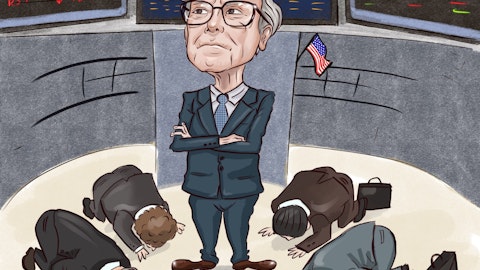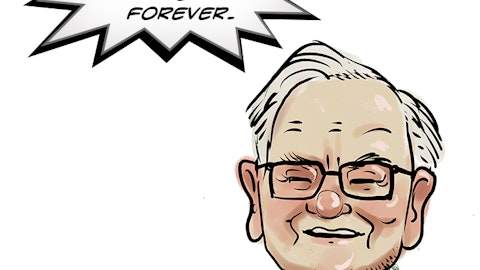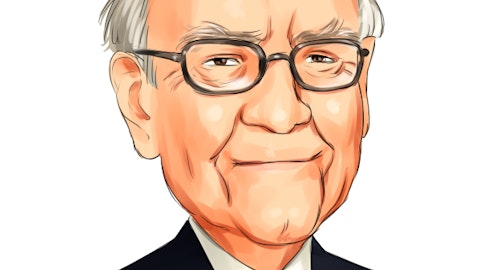Kaio Prato: Hello, everyone. Good night. Thanks for the opportunity for asking questions. I have just one here on my side, please. I would like to talk a little bit more about the future trends. So I think this year you were vocal about mentioning that net income and profitability would gradually recover throughout the year. So I just would like to understand if this speech is maintained for 2023, if we should continue to see higher profits sequentially also in 2023. And what should be the drivers for this going forward, please? Thank you.
Thiago Piau: Hi, Kaio. Thiago, here. Yes, I think that this continues €“ this trend will continue to 2023 based on two effects. We continue to allocate capital towards growth and we are finalizing, a very how can I say this, a very straight zero based budget made by our team that is rationalizing the way that we see COGS and SG&A. So I think that the discipline in terms of OpEx of the companies improving a lot. So revenue should grow faster than OpEx and I think that this operational leverage will take place in 2023, better than we what we did this year. So we expect that the trend of improving overall results and margins continues for 2023.
Kaio Prato: Okay, thank you. And just a quick follow-up on your answer, you mentioned like cost discipline just to have a view if you can talk a little bit more your hub strategy for next year. If you foresee any additional investment to support market share gain or given what you said, you consider that at this current stage you are able to continue to gain share without accelerating investments? Thank you.
Thiago Piau: Hi, Kaio. Yes, we see space to continue to invest in our hubs. I think that we are creating more density in the locations that we already have presence. With this discipline that we said that we are calculating minimum hurdles of return and pricing is something that we are using to adjust our speed of growth. But in the balance that we have today, we see space to continue to allocate capital towards the growth of the SMB using our hubs as the main strategy. So we will create more density next year and continue to grow.
Kaio Prato: Okay, thank you very much.
Thiago Piau: Thank you very much Kaio.
Operator: And our next question will come from Mario Pierry with Bank of America. Please go ahead.
Mario Pierry: First of all, congratulations on the results. Let me ask you two questions, okay? The first one is, when we look at your guidance, you met your guidance for revenues in TPV. But basically, those are two variables where you don’t have much control. And you surprised us on COGS and OpEx. And that’s what you control. So I’m trying to understand like why were you surprised on COGS and OpEx? Are there any specific initiatives that you have underway here to improve efficiency? Or are we seeing any synergies from the Linx transaction? And then I’ll ask my second question.
Rafael Martins: Mario, Rafael here. Thank you for the question. So I think that when we look to the outperformance versus our guidance, I think, the main driver of that was that we underestimated a little bit the level of impact of the repricing waves we have done in the quarter. So I think it was less related to costs and expenses, but more related to the extent of the pricing wave as we have done. We have even done some additional pricing in September. So I think that, that was reason behind the outperformance of the guidance, which led to a revenue net funding costs higher than we expected.
Thiago Piau: Rafael if I may complement, Mario, just regarding synergies with Linx. We are doing two things here in terms of OpEx. One is integrating the portfolio of companies that we have invested over time into the Linx management system and the other one is integrating the back office of Linx into Stone. So I think that this is creating more efficiency, and we will see more results of that next year. So those are the things in terms of OpEx that we are focused right now.
Mario Pierry: Okay. And then my second question then, Thiago, is related right to the change that you’re going to the Board, you’re bringing in Pedro. Someone that has a very different experience, right, like a completely different industry. So what attracted you guys to look for Pedro? How do you think the strategy changes? And as you guys pointed right on Page 16 of the presentation, fairly successful last four years since the IPO, we have over-delivered. So how should we see the strategy change and what exactly do you think Pedro brings to Stone given that the experience is completely different from what you guys do?
Thiago Piau: Great, Mario. I met Pedro in March, between March and April, and I created a very strong relationship with him since he joined the Board, seeking his advices, talking about the opportunities and the challenges of our company. And I think that over that time, it was clear to me that Pedro has the capabilities and the personal values required for the next phase of our company. I trust him a lot. I will remain committed as a partner to support the company and the team in his new role as a Board member. And I think that we are always trying to evolve bringing in new people with additional capabilities to support the expansion of the company. And that’s what we are doing. I think that we are adding more talent. Pedro will be, I think, a very good leader for the company. And I think that we will be stronger. So we are very happy with this movement. And basically, that is the rationale of it. He has the capabilities and the personal values for this next phase.
Mario Pierry: And how do you think the strategy changes then? Again, as you highlighted on Page 16, you increased the presence in software, you were able to grow market share. If you were to think about the next like three years, how do you see the company evolving in which segments?





